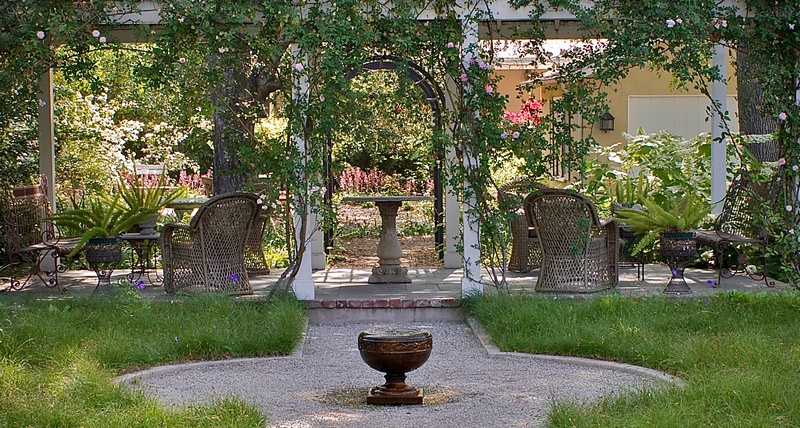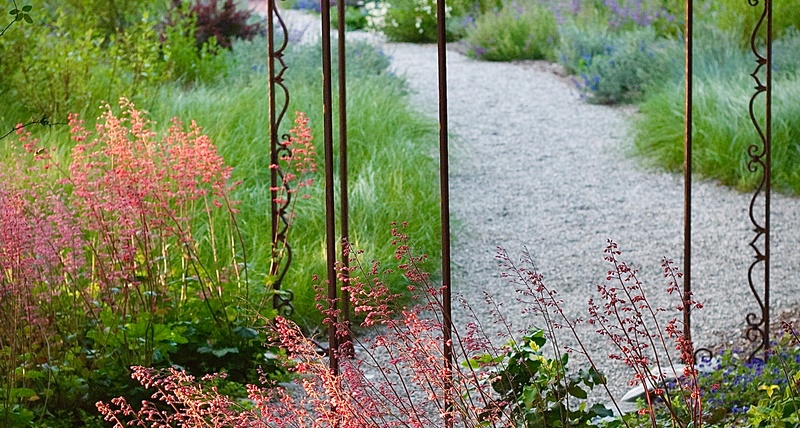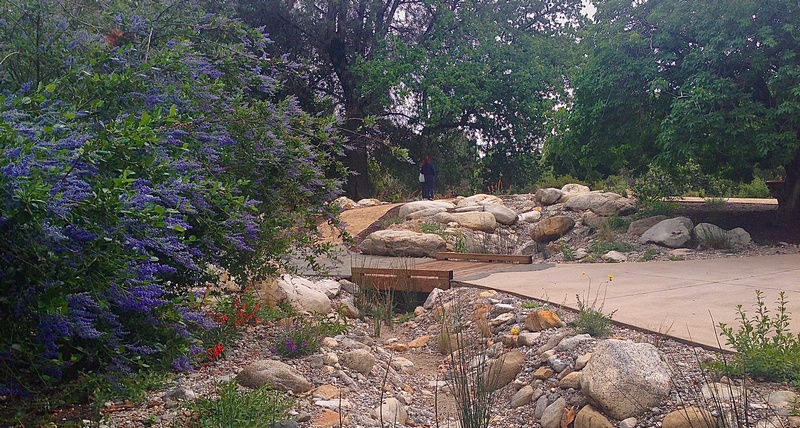
Creating a small “lawn” with our California native Carex pansa which is a sedge. It is drought tolerant, can be cut back to stay low with trimming. It requires low water but looks best with 2x weekly irritation that meets the current water restriction requirements. Grows best in morning to early afternoon full sun. Sun all day under our drought would not make for ideal conditions for growth. The gravel pathways allow for less irrigation while adding accessibility and visual balance. There is a small water feature that the birds visit every day. Off to the rear of the garden room is an oak woodland garden comprised of all California native plants. The pink is the California native Heuchera ‘Rosada’. [Photo courtesy of Wynne Wilson, Principal Designer/Terra Design]

In the foreground is: The bright pink heuchera ‘Rancho Santa Cardinal’ (coral bells), the purple iris douglasiana (Douglas iris), the medium tall grass is Carex praegracilis, all California native plants. The sun exposure is dappled light shade. Once established, these plants would grow well on the twice weekly water requirements. In the distance there is a combination of salvias and lavender. [Photo courtesy of Wynne Wilson, Principal Designer/Terra Design]

California Botanic Garden. Wynne Wilson designed the garden that is all California natives with water capture, a riverbed, and an outdoor pavilion. [Photo courtesy of Wynne Wilson, Principal Designer/Terra Design]
With California facing one of its most severe droughts in our lifetime a question becomes, “What happens to Pasadena’s vaunted gardens?“
Water restrictions are likely to become ever more restrictive and many Pasadenans are pondering drought-resistant plants and even rock gardens.
“These new restrictions are going to force many people to become aware that the water shortage is a very real problem, “said Wynne Wilson, principal at Terra Design of Pasadena. “There are practical and simple methods to conserve irrigation water, and one issue that concerns me is the lack of continued irrigation to the trees whose canopies offer a cooling shade and actually conserve water by lowering ground temperatures.”
As Wilson puts it, it’s really a matter of survival of the fittest.
She explained that people should realize that a water-conserving garden does not have to mean gravel and cactus.
“Our beautiful California native plants are genetically designed to thrive on less water,” she explained. “There are also many beautiful Mediterranean varieties as well.”
Wilson also carefully pointed out that drought doesn’t mean “no water,” it just means less water, and it can be dealt with through proper plant selection, irrigation, and mulching.
As a long-time landscape designer, Wilson said she has seen many homeowners who are resistant to the idea of less watering.
“I see many gardens that waste water needlessly, and often it is simply the homeowners’ lack of experience,” she said. “There are now many available websites and educational classes available to help people make the correct selections.”
Wilson feels as though it is her responsibility to share alternative design ideas that support the climate ecology while fulfilling her clients’ wishes. Fortunately, as she told Pasadena Now in a recent interview, most people are excited to learn how to design a garden that will offer beauty and habitat, as well as a retreat.
Having a smart garden is a matter of not designing with water-thirsty lawns and plants, said Wilson.
“There are ways to create a microclimate in a garden and actually form cooler areas which will support the overall health of the plants in the garden for years to come.”
Wilson explained that over 15 years ago she planted a canopy of trees that have now grown to form a shady area that is 10° cooler in the hot summers.
“We have to be strategic about plant placement as well as irrigation,” she said. “A plant’s roots stay cooler with a canopy of leaves rather than removing the lower branches.”
Wilson has long faced the idea of a drought with optimism.
“Let’s look at this as an opportunity to grow our gardens in a new way. I’m excited to design a garden that will thrive with low water, offer beauty, and support the ecology and wildlife.”
Laramee Haynes, the owner of Pasadena-based Haynes Landscape Design offers specific strategies for dealing with drought in your garden.
“If a lawn is a must,” he said, “plant Saint Augustine grass, as it does not need watering during the winter, reducing your annual water use substantially.”
“Landscape design is largely driven by what customers want,” said Haynes. “A new landscape is expensive, and plants dying in a drought is a grim scenario. Customers want to know that their garden is going to survive and be beautiful.”
Garden owners can also reduce the size of their lawns, and give them a pleasing shape, like a pond.
Haynes said homeowners should use a sprinkler controller that adjusts automatically, using weather information obtained through a Wi-Fi connection. And, rather than a seldom-used front lawn area, homeowners may plant low shrubs with open areas of clean, walkable chipped granite. They can also add wide pathways through the planting and plant large groups of the same plant to reduce visual busyness.
Haynes is also pragmatic when it comes to dealing with homeowners who insist on large lawns or plants which use lots of water.
“Designers can provide information to educate customers on making sensible choices. If a customer insists on a large lawn, or heavy water using plants, the designer can comply, or walk away from the job.”
Haynes stresses that he regularly plants local California native plants and low-water using non-native plants.
“It’s important to recognize the latter, as many of our traditional non-native plants need much less water than we typically provide.”
Haynes also notes that the idea of a large green lawn may be a thing of the past. He recalls that “22 years ago, at the beginning of my landscape design career, the English garden, filled with flowers and a large lawn was firmly in fashion. The cottage garden, filled with tough shrubs and wide pathways, is now a delightful alternative when carefully planned and planted.”
“Regularly I install gardens in compliance with the $2 per square foot Turf Replacement Rebate offered by the state through SoCal Water Smart.”
The bottom line? Plant smartly. Rethink your idea about a lawn. Use plants that won’t drain your water budget, or your community’s.
More information about drought gardening is available at www.terradesigngarden.com and hayneslandscaping.com.








